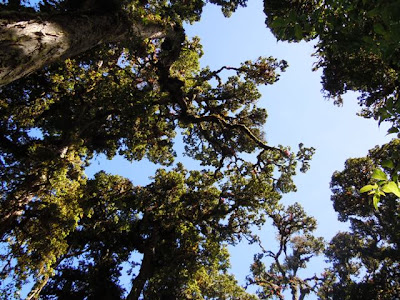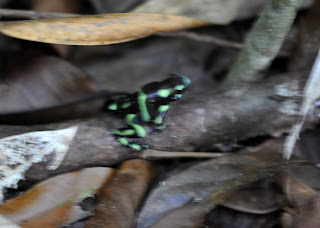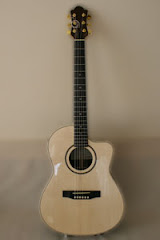After a cruel and hideous all-day drive from San Ramon south on the PanAm up and over the Cuerro de la Muerte mountain range & the Continental Divide (truck traffic, endless curves, fog, heat, potholed roads, dirt roads, etc., etc. - all of which are far more enjoyable on bicycles than in cars!) down to San Isidro & thence to the Peninsula de Osa, Doug and Chris dropped off Jeff and Jason at La Palma, near Corcovado National Park just at sunset. From here, Jeff & Jason would trek to Los Patos Station entrance to Corcovado NP and explore the park by foot over the following 3.5 days while Doug and Chris would continue by rental car another 120 km to Carate, a sparsly populated outpost at the literal end of the road near the La Leona Station entrance to Corcovado National Park, touring the peninsula and staying in eco-lodges.

A basic map of Peninsula de Osa and Corcovado National Park. The route we would take spans about 60km, going from La Palma to Carate, passing by Los Patos, Sirena and La Leona stations en route - thus crossing the heart of the park. Our walk started along the Rincon River, and offered outstanding wildlife viewing:
Roadside Hawk
Scarlet-Rumped Tanager
gorgeous swallowtail butterflies seen along Rio Rincón
the track crossed the Rio Rincón a dozen times or so on our way to Los Patos station, along which we saw a number of species of birds:
Lesser Yellowlegs
American Ibis
Kingbird
Black-Striped Sparrow
the scene near Los Patos. The park begins on the right (west) side of the river here.
crested anole lizard
sundown cicada shell
waterfall 2 km into the park from Los Patos. great for a morning dip
the forest was exceptionally beautiful heading into the heart of the park, and we saw some exciting birds along the way here:
Chestnut-Mandibled Toucan
Pale-Billed Woodpecker
Black-Cheeked Ant-Tanager
some nice flowers as well:
Heliconia, a favorite of hummingbirds
evasive White-Whiskered Puffbird
Jason strings up his newly-sewn hammock across the trail for an afternoon rest
...some beautiful tree forms scattered throughout the forest...
... approaching Sirena station we saw some animated Squirrel Monkeys...
La Sirena Ranger and Research Station
... hiking the trails around La Sirena yielded some interesting sights...
the Rio Sirena meets the ocean
Wandering Tattler
amazing buttressed roots, a common feature of tropical rainforest
as we headed out of La Sirena, we had to ford the Rio Claro. No problem, right?
Jason getting good and wet. When Jeff crossed two minutes later, the tide had risen slightly, and the water level reached his chin!
Whimbrels and Tattlers in the surf zone
a good deal of the walk from La Sirena to Las Leonas passes along or just next to the beach, making for some spectacular scenery
... Giant Anteater! the namesake of the Peninsula de Osa, and apparently a rare sight... he gave a good viewing for about 10 minutes ....
Bare-Throated Tiger-Heron
Red-Legged Honeycreeper, seen while crossing a recent landslide
Common Black-Hawk
sunset from near La Leona station
sunrise the following morning
Scarlet Macaw. Rare in most of Costa Rica now, this endangered bird is common in Corcovado National Park, especially clost to the coast.
While Jeff and Jason started their treking across Corcovado NP, Doug and Chris continued on to Carate. While the all-day drive from San Ramon to La Palma may have been cruel and hideous, at least it was in daylight. La Palma to Carate was driven at night, through pitch black rain forest and jungle, 120 km on mostly unpaved "roads" better described as dirt-layered/rock-strewn/mud-slicked/sand-trapped/non-shouldered/deep-potholed/hair-pinned/un-marked/single-laned/blind-curved/wash-boarded, .... Scariest of all, there were at least 8 river/creek crossings, but there were NO BRIDGES, and at each crossing, the black, flowing waters hid their true depth from our headlights. After finally reaching Carate, we managed to find our first Eco-lodge, Finca Exótica, were shown our open-sided thatched-roof cabino (shown below) and downed a full bottle of wine between the exhausted two of us.
brown pelicans seen along their day-hikes to La Leona
After a restful two nights, they backtracked 36 km (this time, in daylight) to another Eco-lodging, Bosque del Cabo Rainforest Lodge, for another two nights stay:
Chris and Doug at waterfall.
view of Pacific coastline from Bosque Del Cabo
following are some amazing photos of scarlet macaws that Doug and Chris spotted while on nature treks:
Yo! Que pasa?
On the way back to the nest.
Settled in & carrying on a conversation in their nest cavity high in the canopy! Scarlet Macaws mate for life.
We gotta get outta this place.......
the photos below document some more of the diverse wildlife seen in this area of the Osa Peninsula:
squirrel monkey seen near Doug and Chris' cabin at Bosque Del Cabo
breaching humpback whale (!) near Carate, SPLISH........
...........AIRBOURNE.........
.........SPLASH!!!
While taking our first shower (outdoors, of course) at Bosque Del Cabo, we couldn't help but notice that we were being watched by a pair, of, oh-no, YIKES.....
Golden-orb Weaver Spiders.
The larger (7 inches in length) is the female, & the much smaller (on top) is the male. This view is the underside. The female's venom is similar to a Black Widow's, but (thankfully) not near as lethal for humans.
This is a topside view of the Golden Orb-Weaver, female below, male (much smaller) above. Click to enlarge, and you'll see the typical skull face on the female's Cephalothorax, definitely signalling "DANGER!"
Owl butterfly
Rain forest orchid, blended by nature
Hummingbird delight
Pair of Chestnut-mandibled Toucans, (they mate for life), spotted by Chris & photographed by Doug at Bosque Del Cabo.
Red-lored Parrot, watching......
Agouti.
Flying squirrel.
Black-headed Tody-Flycatcher
Crested Caracara
Great Tinamou
White-winged Tanager
Blue-gray Tanager, landing.
Clay-colored Robin, landing.
Pair of Scarlet-rumped Tanagers, in flight, fighting over territorial rights. A classic no-fly-zone battle.
Rain forest ferns.
Green & Black Poison-dart Frog
Banded Peacock-yellow butterfly
sunset near Corcovado National Park
After four full days of flora & fauna, the last two at Bosque Del Cabo, Doug & Chris doubled back to Carate to pick up Jason & Jeff, then ventured once more on that %!~*^#<} 120 km "road" out of the Osa Penninsula & onward to San Isidro de El General in the highlands near Co. Chirripo, the highest mountain in Costa Rica.


















































































































